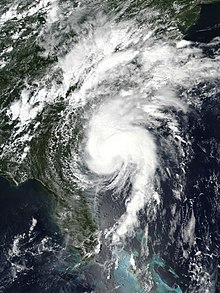
Back Huracán Isaías Spanish Ouragan Isaias (2020) French Uragano Isaias Italian Furacão Isaías Portuguese Hurricane Isaias SIMPLE Isaias Kasırgası Turkish Ісаяс (ураган, 2020) Ukrainian
 Hurricane Isaias intensifying near The Carolinas on August 3 | |
| Meteorological history | |
|---|---|
| Formed | July 30, 2020 |
| Extratropical | August 4, 2020 |
| Dissipated | August 5, 2020 |
| Category 1 hurricane | |
| 1-minute sustained (SSHWS/NWS) | |
| Highest winds | 90 mph (150 km/h) |
| Lowest pressure | 986 mbar (hPa); 29.12 inHg |
| Overall effects | |
| Fatalities | 17 total |
| Damage | $5.03 billion (2020 USD) |
| Areas affected | West Africa, Lesser Antilles, Greater Antilles, The Bahamas, East Coast of the United States, Eastern Canada |
| IBTrACS | |
Part of the 2020 Atlantic hurricane season | |
Hurricane Isaias (/ˌisɑːˈiːɑːs/)[1] was a destructive tropical cyclone that caused extensive damage across the Caribbean and the East Coast of the United States while also spawning the strongest tropical cyclone-spawned tornado since Hurricane Rita in 2005. The ninth named storm and second hurricane of the extremely active and record-breaking 2020 Atlantic hurricane season, Isaias originated from a vigorous tropical wave off the coast of Africa that was first identified by the National Hurricane Center on July 23. The tropical wave gradually became more organized and obtained gale-force winds on July 28 before organizing into Tropical Storm Isaias on July 30. Isaias marked the earliest ninth named storm on record, surpassing 2005's Hurricane Irene by eight days. Isaias strengthened into a Category 1 hurricane on the next day, reaching an initial peak of 85 mph (140 km/h), with a minimum central pressure of 987 mbar (hPa; 29.15 inHg). On August 1, the storm made landfall on North Andros, Bahamas and subsequently weakened to a tropical storm, before paralleling the east coast of Florida and Georgia. As Isaias approached the Carolina coastline, it reintensified back into a hurricane. Soon afterward, Isaias reached its peak intensity, with maximum 1-minute sustained winds of 90 mph (150 km/h) and a minimum central pressure of 986 millibars (29.1 inHg), before making landfall near Ocean Isle Beach, North Carolina, at 03:10 UTC on August 4, at the same intensity. The storm proceeded to accelerate up the East Coast of the United States as a strong tropical storm, before transitioning into an extratropical cyclone over Quebec on August 4. Isaias's extratropical remnants persisted for another day, before dissipating on August 5.
Numerous tropical storm watches and warnings as well as hurricane watches and hurricane warnings were issued for the Lesser Antilles, Greater Antilles, Bahamas, Cuba, and the East Coast of the United States. Isaias impacted portions of the Eastern Caribbean and caused significant damage in the Eastern United States. Devastating flooding and wind damage were reported in Puerto Rico and the Dominican Republic, with many towns without electricity or drinking water. Trees were uprooted and power lines were downed in much of the Eastern United States from both damaging winds and tornadoes, with more than 3 million power outages reported, nearly half of them in New Jersey. Isaias was also the second tropical cyclone to affect the Northeastern States in 3 weeks after Tropical Storm Fay in early July.[2] Many people were without power for days after the storm in New York and Connecticut, leading to investigations into power and electricity companies. There were 17 storm-related deaths (direct and indirect): 14 in the contiguous United States, two in the Dominican Republic, and one in Puerto Rico.[3] Overall, Isaias caused approximately $5.025 billion (2020 USD) in damage, with $4.8 billion in damage occurring in the U.S. alone, making Isaias the costliest tropical cyclone to affect the Northeastern United States since Hurricane Sandy in 2012.[4][5] The Spanish name Isaias was found by many people to be difficult to enunciate, and was mispronounced by some weather forecasters in the United States.[6] Isaias was one of several destructive 2020 hurricanes whose names were not retired by the World Meteorological Organization following the season, along with: Sally, Delta, and Zeta.[7][8][9]
- ^ "Atlantic Basin Storm Name Pronunciations: 2015–2020" (PDF). Miami, FL: National Hurricane Center. 2015. Archived from the original (PDF) on December 20, 2015. Retrieved July 31, 2020.
- ^ Pozarycki, Robert (August 1, 2020). "Tropical Storm Isaias expected to dump heavy rain on NYC later this week (UPDATED)". amNewYork. Archived from the original on August 3, 2020. Retrieved August 5, 2020.
- ^ Andrew Latto; Andrew Hagen; Robbie Berg (March 30, 2021). Tropical Cyclone Report: Hurricane Isaias (PDF) (Report). Miami, Florida: National Hurricane Center. Retrieved April 14, 2021.
- ^ "Billion-Dollar Weather and Climate Disasters: Events". National Centers for Environmental Information. October 2020. Retrieved October 19, 2020.
- ^ AON (September 2020). "Global Catastrophe Report 2020" (PDF). AON. Archived (PDF) from the original on September 14, 2020. Retrieved September 14, 2020.
- ^ "How exactly do you pronounce Hurricane Isaias?". Sun Journal. July 31, 2020. Archived from the original on August 3, 2020. Retrieved August 12, 2020.
- ^ "Greek alphabet retired for hurricane names; 'Isaias' still available". WPRI.com. March 17, 2021. Retrieved March 17, 2021.
- ^ Masters, Jeff (March 19, 2021). "WMO: Atlantic hurricanes no longer to receive names from Greek alphabet". Yale Climate Connections. Retrieved March 19, 2021.
- ^ Jonathan Erdman (March 19, 2021). "These 2019 and 2020 Atlantic Hurricane Names Were Not Retired, But Were Strong Candidates". weather.com. The Weather Company. Retrieved March 21, 2021.